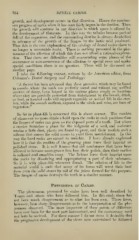Page 754 - My FlipBook
P. 754
764 DENTAL CARIES.
growth, and development occurs in that direction. Hence the continu-
ous progress of caries when it has once fairly begun in the dentine. Then
the growth will continue in any direction in which space is oifered for
the development of filaments. In this way the tubules become packed
full of the organisms, and the surrounding dentine is always decalcified
in advance of the growth of the fungus by the lactic acid produced.
That this is the true explanation of the etiology of dental caries there is
no longer a reasonable doubt. There is nothing presented in the phe-
nomena of the affection of which this does not afford a rational explana-
tion. That there are difficulties still surrounding some phases of the
occurrence or non-occurrence of the affection in special cases and under
special conditions there is no question. These will be discussed on
another page.
I take the following extract, written by the American editor, from
Coleman's Dental Surgery and Pathology:
"A theory has been advanced that these parasites, which may be found
in mouths where the teeth are perfectly sound and without any unfilled
cavities of decay, have lodged in the carious places simply as locations
where they are partially protected from dislodgment by the breath, drink,
or food, as fissured rocks will support vegetable or animal life in the crev-
ices, while the smooth surfaces, exposed to the winds and rains, are bare of
vegetation."
So far as plant-life is concerned this is about correct. The rootlets
of plants can no more obtain a hold upon the rocks in such positions than
the fungus of caries can grow on the exposed parts of a tooth. But where
a crevice furnishes a place for the lodgment of a seed, and moisture
retains a little dust, plants are found to grow, and their rootlets emit a
solvent that causes the solid stones to yield them nourishment. In this
wav the hard rocks are caused to crumble. I have already explained
how it is that the rootlets of the growing plant leave their imprint on
polished stone. It is well known that old tombstones that have been
allowed to become moss-grown first lose their polish, then their surface
is softened and crumbles away. The lichens leave their imprint upon
the rocks by dissolving and appropriating a part of their substance.
So it is with plant-life wherever found. The relation of life to the
material world is such that many of its forms will wrest their food
from even the solid stones by aid of the juices formed for this purpose.
The fungus of caries destroys the teeth in a similar manner.
Phenomena of Caries.
The phenomena presented by caries have been well described by
Tomes and others who have followed him. In this study there has
not been much disagreement as to what has been seen. There have,
however, been sharp disagreements as to the interpretation of the phe-
nomena observed. The more important of these points of difference
have now been for the most part harmonized, and the controversy need
not here be revived. For these reasons I do not deem it desirable that
the progressive development of the views now entertained be followed


